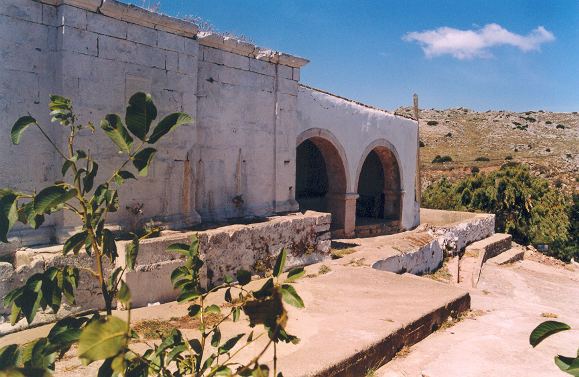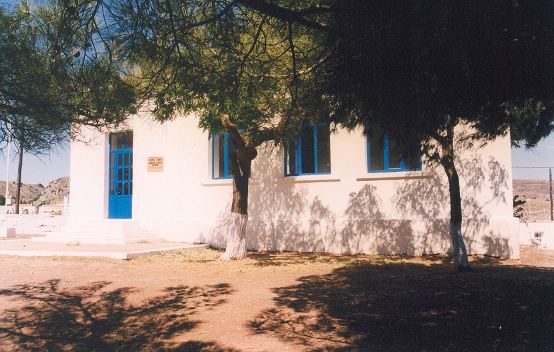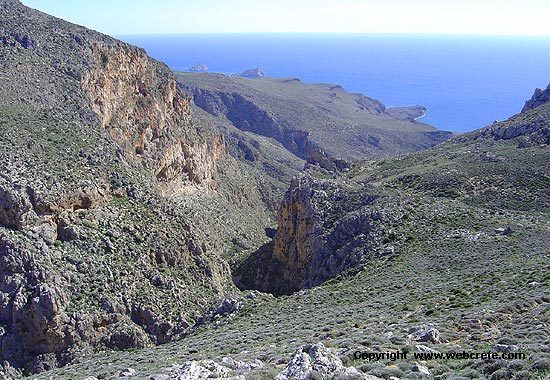A world-famous tourist resort north of Agios Nikolaos, with lacy, windless sandy beaches, crystal clear…

Karidi
This village, about 25 km from Sitia, 23 km from Palekastro and 600m above see level, is reached either by a road that passes through various mountain hamlets (Metochia Piskokefalou) or by a new road that branches off the road from Palekastro to Zakros near Adravasti; it is approximately 8 km from the main road. A stone slab with a sculpted relief of a branch of walnut tree complete with nuts, is said to have been found at a local place called Koutsounara, and the name of the village is derived supposedly from this find (Karidia: walnut tree).
In the Venetian census of 1583 it is not mentioned. although it is marked on contemporary maps and mentioned in deeds of the period.In proper excavations have yet been carried out, but of the chance finds from the district the most important is a very fine stone double axe which is now ίπ the Iraklion Museum.
There are two noteworthy caves in the Karidion area, both with traces of inhabitation. They are the Katofigi cave at Limnilakkos and the Peristeras cave. This latter is one of the more important Cretan caves. It is 1 km east of the village, some 300 m north of the public road, and the place is known both as Plativolo and Peristeras.
The mouth of the cave is 540 m above sea level. It is a deep subterranean cavern opening into Jurassic Limestone, and there is a difference of 63 m between the level of the entrance and the lowest point.
The opening is 23,5 m wide and 12 m high, but a big rock fall prevents close examination of much of the entrance area. From here one passes into a huge chamber 80 m deep and 35 m wide; at part the height varies between 2-12m. At the left of the back of this chamber a narrow gap leads, after a sharp drop of 4m, into a series of curved chambers which swing round to connect up again with the left wall of the main chamber.
Nature has adorned the first two chambers richly with stalagtites, stalagmites and pillars of stone. In the third and fourth chambers human bones were found, and other signs of habitation. From examination of the sherds it has been concluded that the cave was in use from the early minoan to the Late minoan period, and also in Byzantine times.
From the book “Sitia”, N.Papadakis, Arcaeologist,1983
Sitia Natural Geopark
Karidi Info Center
Sitia Natural Geopark
The Info Center at Karidi is hosted at the old school of the village and is dedicated to the speleological research. The center offers information on the Nature Park, the nearby geo-routes and the activities that can be implemented, but also can be used for accommodation of small groups and scientists.
Center is equipped with the necessary infrastructure and facilities for stay and sleep that can be used by speleologists, biologists, schools etc., that are interested to study the environment and caves of this mountainous area. It also can provide visitors with the necessary equipment for personal security and orientation.
Visitors who wish to use this infrastructure should communicate with Parks authorities or the Municipality of Sitia.
Additional Info
Location: Sitia Region – 18 km from Sitia – 23 km from Palekastro
Access: Aphalt road
Residents: 5-10 (2012)
Αltitude: 570m
Peristeras Cave
The elevation at the entrance is 540 metres, whereas the elevation at the rim of the doline attains 564 metres.…
Pano Peristeras Cave
It is one of the biggest caves in Crete. There is an underground river with a mapped length of routes…
Cycling in East Crete
If you are a mountain bike lover or healthy living is part of your life, then here’s your place to…
Oxo Latsidi Cave
The elevation is about 610 metres. The cave is formed in Jurassic limestone. A little more northern, there are Permo-Triassic…






















This Post Has 0 Comments